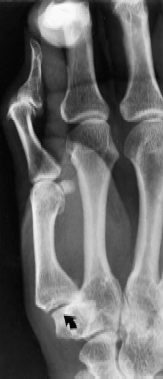68
Osteoarthritis: Carpometacarpal Joint (Ligament Reconstruction with Tendon Interposition)
Vincent Ruggiero and Andrew K. Palmer
History and Clinical Presentation
A 55-year-old right hand dominant woman presents with the complaint of pain of 3 years’ duration in the right thumb. The pain has progressed to the point where it now interferes with her activities of daily living in her house and garden. She complains of weakness of both pinch and grasp. She denies any numbness or tingling in her fingertips or loss of motion of the hand or wrist.
Physical Examination
There is tenderness and swelling about the basal joint of the thumb. Axial compression causes pain and palpable grating at the basal joint of the thumb. The thumb carpometacarpal (CMC) joint is unstable to stress testing. Her thumb metacarpal is adducted and the metacarpophalangeal (MP) joint of the thumb hyperextends 15 degrees on stress testing. Her pinch and grip strengths are decreased by one-half of her nondominant side. She has negative Phalen’s, Tinel’s, and Finkelstein’s tests.
Diagnostic Studies
Anteroposterior (AP), lateral, and stress views of the thumb reveal grade 2 osteoarthritic changes of the metacarpal-trapezial joint and scaphotrapezial joint with subchondral sclerosis, cystic change, and surrounding osteophyte formation (Fig. 68–1). A stress view, which is obtained with the thumb and index at maximal pinch, reveals mild radial subluxation of the first metacarpal-trapezial joint (Fig. 68–2).

Figure 68–1. (A) Anteroposterior (AP) view of the carpometacarpal (CMC) joint with both trapeziometacarpal and scaphotrapezial degenerative changes. (B) Lateral view with same findings.
PEARLS
- Be sure to dissect the FCR free to its insertion on the index metacarpal to ensure the best possible ligament reconstruction.
- When securing the ligament reconstruction, be sure to pull traction on the thumb metacarpal and obtain maximal adduction of the metacarpal base. When the base is maximally adducted the thumb ray will be abducted.
- If the bony bridge between drill holes fractures, make a second drill hole dorsoradial.
PITFALLS
- When removing the trapezium, be careful not to damage the FCR, which is directly below.
- Not addressing the associated MP hyperextension will lead to instability with pinch and can contribute to failure of the CMC arthroplasty.

Figure 68–2. Maximum pinch view demonstrating mild subluxation of the CMC joint with degenerative change (arrow).
Differential Diagnosis
Carpometacarpal arthritis
Carpal tunnel syndrome
De Quervain’s tendinitis
Flexor carpi radialis tendinitis
Trigger thumb
Diagnosis
Carpalmetacarpal Arthritis: Pan Trapezial
Note the scaphotrapezial joint has arthritic changes also.
Carpometacarpal arthritis is a common condition that has a predilection for middle-aged women. This may be a sequela of idiopathic hypermobility of the CMC joint. It can also be associated with trauma or inflammatory diseases. Activities that require strength and/or mobility of the thumb are difficult to perform. Examples are key pinch and opening a jar.
Eaton has classified CMC arthritis into four stages. Stage I is characterized by no joint degeneration and articular contours that are normal. There may actually be widening of the joint space secondary to an effusion. Stage II is characterized by slight narrowing of the trapeziometacarpal joint on radiographs. If any joint debris is present, it is less than 2 mm in size. Stage III is characterized by significant trapeziometacarpal joint destruction radiographically. Sclerotic and cystic changes are noted in the bone. Stage IV is characterized by scaphotrapezial degenerative arthritis in addition to the changes seen in stage III.
Surgical Management
Ligament reconstruction with tendon interposition (LRTI) is our preferred treatment for the late stages of CMC arthritis. The reconstruction of the volar beak ligament prevents thumb ray shortening and instability. The arthroplasty helps to prevent collapse of the thumb. We usually perform a complete trapezial resection, as most of our patients have some degree of scaphotrapezial arthritis that may not be evident on radiographs.
Stay updated, free articles. Join our Telegram channel

Full access? Get Clinical Tree








